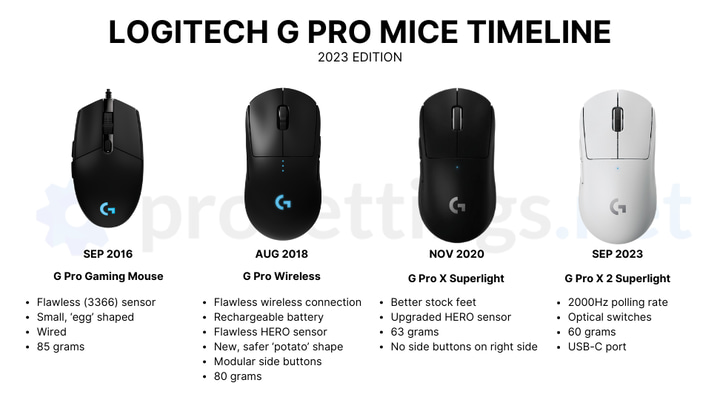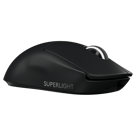The Rise and History of the Logitech G Pro Wireless/Superlight

The question ‘what is the best gaming mouse?’ is one that we get a lot. It’s only natural, since we’re a website dedicated to professional gaming gear and settings, but it’s still a question that has historically been difficult to answer. After all, a lot of what makes a gaming mouse good comes down to personal preferences and subjective factors.
And yet, there is one mouse that has defied that notion for years now. Ever since its release, the G Pro Wireless (and G Pro X Superlight) has graced the desks of the most prolific professional gamers in the world, and this phenomenon can be seen across the borders of games. From VALORANT to Overwatch (2) to PUBG and Apex Legends, the G Pro mice take first place as the most used mice by pro gamers. A spot that the mouse hasn’t given up since its release in the second half of 2018.
But why is this? How, in a market with so many options and approaches to design, did this particular mouse, with this particular shape, manage to become the pointer of choice for over one third of professionals across all of our analyzed games? In this article, we’ll try to answer that question, and we’ll go over the history of the G Pro Wireless and its successors, the G Pro X Superlight and G Pro X 2 Superlight.

Sponsorships?
Before we get into the meat of the article, we have to address the elephant in the room. Whenever there’s talk about gamers preferring a certain piece of gear, there’s also talk of sponsorships, and how all of it is marketing.
It’s of course blatantly obvious that peripheral manufacturers sponsor players, whether it’s through their team or via a personal sponsorship. Just take a look at the jerseys of pro teams and you’ll probably find the logo of a peripheral brand on there. Mice are in a rather unique position, however.
Brands sponsor players and teams because those organizations and individuals have a lot of eyes on them, thus increasing the sponsor’s brand exposure to the market. A lot of this popularity has to do with player (and team) performance, however. A player who isn’t performing won’t make it to the big tournaments, won’t gather as many fans, and just simply won’t have the kind of pull that a better performing player has. As such, it’s in the interest of brands to allow professional gamers to freely choose their own mice.
We see this in practice a lot. There are tons of teams who have brand A as a main peripherals sponsor when all of their players are using mice from brand B. Given the that a mouse (contrary to something like a headset) is something that’s almost always covered by a hand and is of critical importance to player performance, it’s simply not in the interest of brands to force players to use a mouse that doesn’t suit their preferences.
With that being said: of course companies send out gear all the time, and of course main sponsors will try to nudge the most popular players towards using their gear, but our experience learns that the gaming mouse scene at the highest levels of competitive play isn’t as beholden to sponsors as you might think.
So while sponsorships and free gear being sent to influencers will have no doubt played a role in the success story of the G Pro Wireless, it’s by no means the entire story. To know that story, we have to start at the very beginning.
What’s in a name?
Gamers with some years behind their name will possibly know that the G Pro Wireless wasn’t the first Logitech mouse to be named ‘G Pro’. That honor fell to the mouse that we now call the ‘G Pro Gaming Mouse’.
Initially released in 2016 alongside the G403, the mouse that’s now called the Logitech G Pro Gaming Mouse was initially called the ‘Logitech G Pro’. It was a small, egg-shaped mouse with feather-light buttons focused squarely at the professional gaming market, and was rather quickly picked up by professional Overwatch players.
The G Pro (2016) and the G403 were the first gaming mice to house the PMW3366 sensor. That sensor kind of revolutionized the gaming mouse industry because it was the first truly flawless mouse sensor. Granted, the 3310 (which was the most popular and common sensor at that point in time) was mostly flawless, but it could still spin out under certain circumstances, an issue that was completely eliminated with the 3366 mice.
Despite having a completely different shape from its eventual successors, the Logitech G Pro 2016 did lay the foundations for the success of those successors due to it being the first gaming mouse with a flawless sensor.
Logitech’s logical evolution
The G403 and G Pro were met with a lot of praise from both critics and enthusiasts alike for being no-nonsense mice focused on competitive gamers, but it wasn’t until a bit later that the ball really got rolling.
In the year after releasing the G403 and the G Pro, Logitech unveiled their LIGHTSPEED wireless technology. This tech revolutionized the gaming mouse industry, as it was the first implementation of wireless technology that could stand up to the demands of professional gamers. It had no delay and no drops in connection, making it as reliable as wired mice. Having wireless mice be on par with their wired counterparts (as far as the connection goes) had been a pipe dream for years, and now it was finally a reality.
The G Pro Wireless (2016) got the wireless treatment in May of 2018, making it the first sub-100 gram wireless competitive gaming mouse. The name was also changed to ‘Logitech G305’ (G304 in Asia), with the wired version still called ‘G Pro’ at that point in time.
The G305 marked another milestone in competitive gaming mice, but it was quickly overshadowed by leaks of something even better on the horizon. One of the more prominent leaks came from (then) professional Overwatch player babybay, who showed Logitech’s newest release on stream, and the rumor mill quickly got going.
Born is the king
In August of 2018, the Logitech G Pro Wireless was unveiled, and it shocked the gaming world. It had Logitech’s very own HERO sensor, which was developed to draw less power while still delivering flawless performance, allowing the G Pro Wireless (commonly abbreviated to GPW) to have a rechargeable battery that offered 60 hours of gaming with the RGB turned off. Combining this with a very low weight (at the time) of 80 grams, Logitech’s flawless LIGHTSPEED wireless technology, and a shape that was made to be much safer than what the G Pro (2016) offered, we saw a mouse that was miles above what competitors were offering at that time.
The GPW was developed with pros, for pros, and while this is a marketing line that’s often used by gaming companies, it did seem to ring true here. The mouse was quickly picked up by prolific professionals, and from the moment it started hitting the desks of professionals, there was no stopping its rise to the throne of gaming mice. In record time, it topped the usage charts of games like Overwatch, and other games would soon follow suit. It took the G Pro Wireless less than a year to become the most used gaming mouse overall, a position that it only gave up when it passed the crown to its predecessor.
Logitech G Pro Wireless
Used by 47 players ()Logitech has set out to create the ultimate gaming mouse with the G Pro Wireless, and as far as I’m concerned they have succeeded in that task. It’s without a doubt one of the most hyped up releases of the past few years, and for good reason too.
Pros
- Fits most hands and grip styles
- Flawless wireless performance
- Great battery life
Cons
- High price
- Micro USB charging port is getting outdated
Specs
| Sensor | HERO |
|---|---|
| Polling Rate | 125 / 250 / 500 / 1000 Hz |
| Button Switches | Omron |
| Connection | Wireless |
| Shape | Ambidextrous |
| Length | 12.5cm |
| Height | 6.3cm |
| Weight | 81g |
| Width | 6.3cm |
Going Superlight
It took competitors over a year to catch up to the overall package that the GPW was offering (mainly due to the fact that no one had wireless technology that was on par with LIGHTSPEED) but of course technology develops at a rapid pace, so by mid 2020 there were definitely some alternatives on the market for people who wanted a top-specced wireless gaming mouse.
By then, ultralight mice had taken over the market, with companies scrambling to develop the lightest gaming mouse in existence. This trend, along with the fact that other companies were making mice that, under the hood, surpassed what the GPW was offering, caused gamers to wonder what Logitech’s reply would be.
That reply came in November of 2021, when the Superlight was released. The mouse kept the same shape as the GPW (after all: why change a shape that has been adopted by around a third of pro gamers) but had some improvements in the form of the feet, buttons, battery life (which went up to 72 hours of ingame usage), and (most notably) the weight. Coming in at just 62 grams, the G Pro X Superlight firmly landed itself in the category of ultralight mice, and it was the lightest flawless wireless gaming mouse at the time of its release.
The Superlight (commonly abbreviated as GPX) took what made the GPW so loved, and tweaked that lauded design a bit in order to bring Logitech’s flagship mouse in line with modern mouse standards, and that approach worked. While pro gamer uptake was initially a little bit slow, we now see that GPX’s usage numbers dwarf those of the GPW.
Logitech G Pro X Superlight
Used by 293 players ()If you’re looking for an ultra lightweight wireless mouse with a safe shape this is a top option.
Pros
- Fits most hands and grip styles
- Good battery life
- Flawless wireless performance
- Lightweight
Cons
- Micro USB charging port
- High price
Specs
| Sensor | HERO |
|---|---|
| Polling Rate | 125 / 250 / 500 / 1000 Hz |
| Button Switches | Omron |
| Button Force | 65g |
| Connection | Wireless |
| Shape | Ambidextrous |
| Length | 12.42cm |
| Height | 3.96cm |
| Weight | 62g |
| Width | 6.06cm |
The GPX 2 Superlight
After many months of speculation and fake leaks, Logitech finally unveiled the G Pro X 2 Superlight in the second part of 2023. This new version pretty much brings the Superlight line up to modern standards, as it adds a USB-C port, as well as optical switches and the possibility of using polling rates of up to 8000Hz.
Even though this release was met with some criticism in the mouse community, it’s a logical release if you ask us. The Superlight is one of the most popular mice ever in the professional gaming scene, so messing with what made it such a success would be a silly move. With that in mind, doing a simple update so that the internals and the tech behind it are up to par without changing the shape or weight is a smart move.
With the addition of optical switches (which eliminates the chances of the mouse double clicking), a USB-C charging port, and a polling rate of up to 8000Hz, the Superlight is ready for the year 2023 and beyond, so it’ll be interesting to see if any mice can take the crown off of this behemoth.
Logitech G Pro X Superlight 2
Used by 271 players ()Logitech played it safe with the Logitech G Pro X Superlight 2, but that’s understandable. It’s a new version of one of the most-loved mice in all of professional gaming that introduces a couple of tweaks to bring Logitech’s flagship offering in line with today’s mouse standards.
Pros
- Super safe shape that’ll fit anyone
- Nice coating
- Extremely reliable wireless and sensor performance
- Addition of USB-C charging and optical switches addresses the two most commonly heard complaints about the GPX
- Sensor calibration tool in G HUB is really handy
- Good battery life
Cons
- Clicks feel heavier than on earlier versions, which might not sit well with everyone
- Bottom skate has a different shape, which feels like an unneeded change
Specs
| Sensor | HERO 25K |
|---|---|
| Polling Rate | 125 / 250 / 500 / 1000 / 2000 / 4000 / 8000 Hz |
| Button Switches | LIGHTFORCE Hybrid |
| Button Force | 98.4g |
| Connection | Wireless |
| Shape | Ambidextrous |
| Length | 12.42cm |
| Height | 3.96cm |
| Weight | 59g |
| Width | 6.06cm |
What makes it so good?
There’s no doubt that one of the major contributing factors to the success of the GPX lies in its shape. The very first G Pro mouse (the one launched in 2016) was a remarkably impressive release, but its small, egg-like shape prevented it from being used by a lot of people due to it being such a polarizing design.
Logitech learned their lesson, and the G Pro Wireless was molded to have a shape that would fit almost every hand size and grip style. This ultra safe shape does means that it doesn’t exactly excel at anything: it’s almost never mentioned as ‘the best’ mouse for any specific grip style, but that probably wasn’t Logitech’s aim. With this mouse, there’s no need for lengthy adjustment periods or nights of pondering whether or not the shape will suit you: you just know that you’ll be able to make it work.
Combine that shape with state-of-the-art technology and solid design choices (flawless wireless tech, flawless sensor, long battery life, good coating, feet, …) and you’ve got a mouse that is extremely easy to recommend and use.
Of course the ‘first to market’ principle also applies here. The G Pro Wireless with its LIGHTSPEED technology was lightyears ahead of its competitors for over a year, meaning that it was pretty much the only option for people who wanted to play at a high level while going wireless. Once you find something that works, you’re not very inclined to go for something else, and with Logitech keeping its flagship up to date with market standards or even surpassing those standards, it’s hard to see a world where Logitech’s main mouse is going to lose a significant amount of traction anytime soon.
What does the future hold?
With the Superlight now up to modern standards thanks to the release of the G Pro X 2 Superlight, there shouldn’t be anything that’s holding the mouse back from keeping its crown as the de facto standard issue esports gaming mouse. The people at Logitech really seem to have found the recipe for success here, so the sky seems to be the limit.




















Nice review
Thanks!
It’s a great site. All the best in your future work. By the way, I was looking for a replacement for the RAZER Deathadder essential that broke and the other day I bought Lamza x Fnatic Thorn thanks to the good reviews on the internet and mostly thanks to you and your website. Mouse is flawless perfection. Shape, weight, switches, sensor… I have absolutely no complaints and I use it exclusively in CS2 and it turned out to be perfect. I certainly chose well. I was skeptical at first until it arrived, but when it arrived and I tried it, I knew I made a good choice, especially since the Logitech G pro X superlight was in the plan and I’m lucky I didn’t buy it, even though it’s bad , but I tried it on at a friend’s place and it’s simply not comfortable for me. In any case, thank you and best regards. Angelo, Belgrade